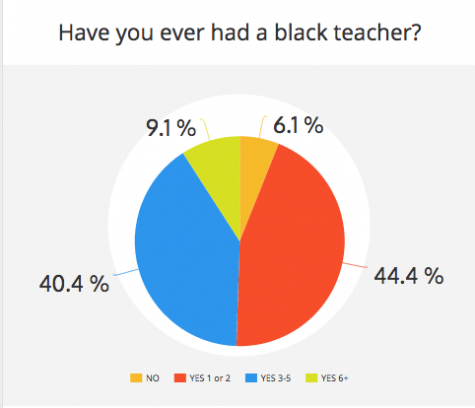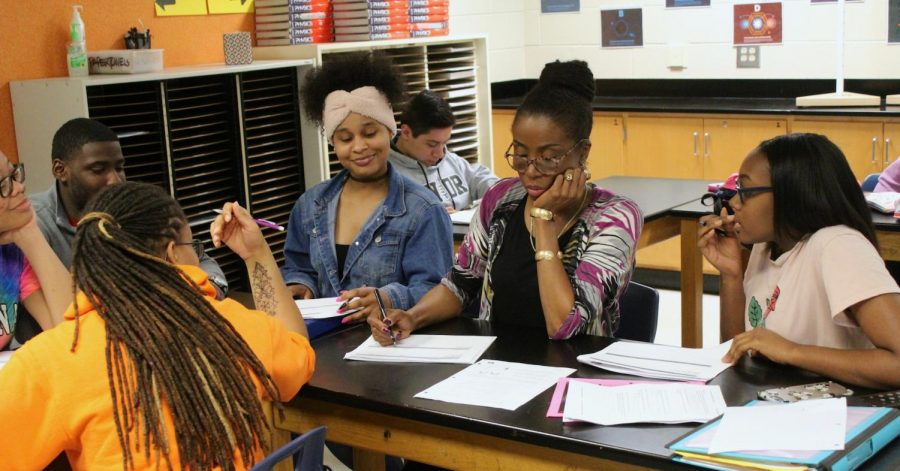Risks without representation: Nationally, diverse classrooms without diverse educators
May 17, 2018
Physics teacher Elizabeth Walker conducting a study session during lunch with her students. As the only black female teacher in the science department, Walker aims to inspire young girls to pursue careers in the STEM field. She attributes the lack of diversity in education to the extensive steps it takes to become a teacher. “The issue of finding people to educate is not as difficult as the red tape an educator must go through to only become a teacher… The problem rests with the narrative of what public schools are… and like I said there’s a lot of bureaucracy involved in education now that really leaves a bad taste in the mouths of anyone aspiring to make this a lifelong career,” Walker said.
The U.S. places a high value on education, encouraging kids to pursue higher levels of learning to increase their chances of landing a well-paying job and contributing to society. In an article about the impact of education, CBS News referred to the “…transformative power of education to elevate us above myriad problems in society.”
With schooling on such a pedestal, it makes sense to take every possible measure to ensure success for the next generation. Diversifying the teacher workforce would positively affect children by exposing them to different cultures, providing representation for minorities, and increasing levels of success for minority students.
People of color push for increased participation in film, television, and sports, yet not in education. According to a study released by the U.S. Department of Education in July 2016, “The elementary and secondary educator workforce is overwhelmingly homogenous (82 percent white in public schools).”
Kids of color deserve more than just athletes, actors, and performers as role models. Entertainers can positively influence younger generations, as demonstrated by Beyonce’s scholarship fund for black girls studying creative arts, music, literature, and African-American studies at select schools, and Yankees superstar Mariano Rivera’s charity work in impoverished areas, building elementary schools and organizing donation drives for children.
However, restricting colored role models to singers, dancers, and athletes puts limits on the aspirations of children. They want to emulate those they look up to, so to see people with like-features in positions of power and as intellectuals in addition to those on television enables them to consider options off the beaten path.
“Kids need people they can see themselves in. I’m a white woman. I can stand here and preach all day. The problem is they need to see other people that are just like them, doing these things so they can say ‘I can do that too!’ I think it’s an incredibly powerful experience,” English teacher Renee Brown said.
Diversity in the educator workforce rose five percent over the past 25 years, shifting from 13 to 18 percent since 1987. Unfortunately, the data does not reflect growth across every non-white racial and ethnic group. While the amount of Hispanic and Asian public school teachers increased by five and one percent respectively, the number of black teachers decreased by one percent, and teachers of American Indian or Alaskan native descent fell from approximately one percent to one-half. These statistics prove that American public schools struggle to employ people who look like and represent the children of color they teach.
The need for diversity does not stem from inadequate white teachers; a quality educator can relate to kids and provide them with the necessary tools to succeed regardless of race. However, white students benefit from diverse leaders just as much as their counterparts. Kids exposed to different cultures earlier in life learn lessons about tolerance that those in homogeneous classrooms do not. Learning from people of various races, religions, and socioeconomic backgrounds exposes children to views different than those with which they have been raised.
“The most important thing you can get out of an education is the ability to be open, to receive new things, and it may not be relevant in the moment, but why not just enjoy the experience? Education should afford you the experience, then light the fire of curiosity for you to go further,” physics teacher Elizabeth Walker said.
On the same note, robbing children of exposure to diversity does not prepare them for life outside school, further perpetuating negative stereotypes and outdated values instead of working towards equality and acceptance. Although American society continues to make strides in civil rights, people of color still face the effects of racism everyday. According to the The Washington Post, “348 people have been shot and killed by police in 2018.” Of those 348, people of color made up 33.6% of victims; considering they only make up 26.7% of the population, it appears police disproportionately shoot non-white suspects. Yet, opponents of the #BlackLivesMatter movement claim race does not affect matters of police violence.
In a more subtle instance, Harvard psychiatrist Chester Pierce, M.D., coined the term microaggression, a term the American Psychology Association defines as a “…brief and commonplace daily verbal, behavioral, or environmental indignities, whether intentional or unintentional, that communicate hostile, derogatory, or negative racial slights and insults toward people of color.”
Plainly speaking, people tend to act, speak, or create situations with negative connotations towards minorities, whether they know it or not. The University of California in Santa Cruz compiled a list of examples highlighting unconscious microaggressions like a woman clutching her person when a Black or Latino man passes by, to environmental situations such as a college naming all their buildings after white heterosexual males. Besides immediate discomfort, victims of these snubs experience low self-esteem, depression, and physical ailment in the long term.
Without any exposure to the sensitivities of minorities, people easily dismiss the harmful effects of microaggressions and rationalize the murders of unarmed suspects. John King, former Secretary of Education, pointed out the difficulties adults face during times of conflict when they lack experience with people of other races and the inability to look past physical differences makes it harder to show compassion. Diverse interaction, such as learning from teachers of color, would enable them to see the damage intolerance does to marginalized groups and avoid prejudiced tendencies that others perpetuate.
“Growing up I’ve always been surrounded by a diverse group of people, and as a kid, I feel like this early exposure raised me to appreciate all cultures. Obviously, I knew racism still existed in the world, but I didn’t realize how prevalent it is in my community until I started working. The last two places I worked at were primarily white people. Someone will make a racist comment or joke, and it was crazy to me the way they just assumed I’d feel the same way and laugh and agree, young and old, men and women. I feel like diversity shaped me to be like a good person, more open minded and accepting,” senior Chelsea Scarborough said.
Teachers act not only as educators, but as mentors, nurturers, and confidants. Kids look to authority figures to feel safe and understood. Each teacher brings their own unique style to the classroom, so a diverse staff increases the chances of students finding a teacher they can fully relate to. Not that differences in race, gender, or age prevents people from forming bonds, but empathy comes easier to those who share similar experiences.

The yearbook staff featured teacher and coach Matthew Sanders after seniors voted to dedicate a section to him for his impact on the class of 2018. In the past two years, Sanders connected with students by listening to their troubles, offering sound advice, and inspiring them to go further in life. “It’s certainly not a glamorous job, not by any means. Grading papers, teaching facts, and trying to motivate students who sometimes may not want to learn certain topics can be discouraging. People may feel like they get nothing out of it because there’s no immediate byproduct, but sometimes you don’t see it until the byproduct until students go off and become adults. That’s when you realize that they learned something from you that worked for them, and that’s what makes it worth it,” Sanders said.
A testament to this claim, U.S. history teacher and basketball coach Matthew Sanders started working at NC in August of 2016; in just two years, he earned himself the senior teacher dedication in the yearbook because of his ability to connect with current and former students, even ones who did not take his class. Sanders builds up his players and empathizes with those who feel misunderstood. His open-door policy creates a kind, intimate culture where kids can freely express themselves and seek advice about problems in their lives.
Acknowledging his role as a mentor of color, Sanders says, “…me being a minority myself, I think that’s the good part of it, I can talk to them about certain things that maybe some of their other teachers can’t talk to them about. I can connect with them in ways that maybe some other teachers didn’t. But at the same time… there is a certain level of respect that has to be maintained.”
When it comes to discipline, empathy plays a powerful role. African-American students face more disciplinary action than any other group in America. According to the U.S. Department of Education, “Studies of school discipline across the years in many places usually find that African Americans are disciplined three times more often than whites. Black children are only 18% of the school population, but a recent report by the U.S. Department of Education found that they experienced 35% of suspensions and 39% of outright expulsions from schools.”
The disproportionate rate of harsh punishments stems from damaging perceptions of colored students. Starting as young as ten years old, people view black boys as older and less innocent, holding them responsible where their white counterparts benefit from the notion of purity. Building on that report, the Georgetown Law Center found that survey respondents believe black girls, compared to white girls, need less nurturing, protection, support, comfort, and know more about adult topics, such as sex. These assumptions occur when adults judge children’s behavior based on stereotypes rather than knowing the individual. Without a deep understanding of troubled students, teachers write them off as disrespectful and lazy, when in reality, no one took the time to understand them.
Adrienne Thomas, mother of two children in the Cobb County school system, said “You have teachers that do their job very well, but when a black kid starts acting out, they don’t understand it, so they label our children. Culture makes a huge difference. That’s not to say that every Black teacher gets it, but they’re more likely to. I grew up in the hood, and most of my teachers were white, but they were more mature teachers that understood our circumstances. We were poor and impoverished, so even though they didn’t live there, they knew why we were the way we were.”
Administrator and Assistant Principal Kiel Southwell impacted NC as the first black male administrator in the past four years, preceded by Landon Brown. Brown earned the respect and love of the student body through his unique personality and optimistic demeanor, and now serves as a championed principal at Stambaugh Charter Academy. Southwell realizes the importance of his position, looking at Brown’s legacy and understanding that black men make up only two percent of the educator workforce. He spends time talking to students that usually spend their time in ISS and OSS.
During an inquiry about how he reaches these struggling students, Southwell said, “Just because of the way some kids have come up, they might be reluctant or even defensive when dealing with people of other races. I know a lot of times when I’m dealing with kids with backgrounds similar to my own, it does make it easier. I understand their situation, I can feel where they’re coming from, and we can get along just because we’re familiar with each other. I think if we had more black male teachers, black male students would be doing better.”

The Chant surveyed seniors and alumni of NC through face-to-face interviews and social media polls, questioning whether or not they have ever had a black teacher. Surprisingly, nearly half of the respondents said out of their 13 years of general education, they only had one or two black teachers. 40% said they had three to five black teachers, nine percent said they had six or more, and six percent said they never had a black teacher in their life.
With such an impact on the development of the next generation, fighting for increased diversity should rank number one on America’s list of problems. However, the tiny pool of candidates for minority teachers continues to grow smaller. A 2016 report by the Brown Center for Education Policy at Brookings found that while black and hispanics enter college at proportional rates, they fail to persist in school. Between their freshman and senior years “…nearly half of all white 22-year-olds (47 percent) have earned a bachelor’s degree, compared with 28 percent of black 22-year-olds and 20 percent of Hispanic 22-year-olds.”
Furthermore, few degree holders express interest in entering the education field, considering careers with higher salaries to pay off student loans or raise socioeconomic status. With more funding, better recruiting resources, and less “red tape” for potential teachers, the school system could transform itself and benefit children now who will change the future.
Karen Scarborough, the director for the Reach for the Stars after school program in Cobb County, described her wishes for the future of education and the pool of applicants for future educators: “I take a look outside the norm for people who may not be in the education field, but are really good teachers. It’s important to have a certificate and your teaching degree, but there are people out there in the accounting field, fashion industry, and different entities of business that would be excellent teachers. But because of the barriers, we’re lacking those people.”
